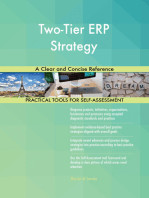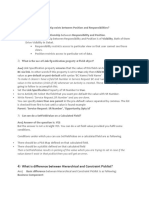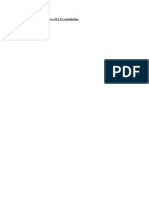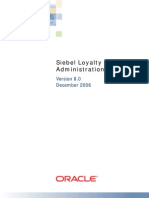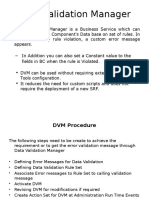00ess - Essentials (Siebel 7.7) Training
00ess - Essentials (Siebel 7.7) Training
Uploaded by
sayedasrarhCopyright:
Available Formats
00ess - Essentials (Siebel 7.7) Training
00ess - Essentials (Siebel 7.7) Training
Uploaded by
sayedasrarhOriginal Title
Copyright
Available Formats
Share this document
Did you find this document useful?
Is this content inappropriate?
Copyright:
Available Formats
00ess - Essentials (Siebel 7.7) Training
00ess - Essentials (Siebel 7.7) Training
Uploaded by
sayedasrarhCopyright:
Available Formats
Module i: Essentials (Siebel 7.
7) Training 1 of 19
Siebel Technical Training
Essentials (Siebel 7.7)
November 2004
Module i: Essentials (Siebel
7.7) Training
Module i: Essentials (Siebel 7.7) Training 3 of 19
Module Agenda
This module provides an introduction to the:
Instructor and class participants
Training site information
Course:
Audience
Prerequisites
Goal
Objectives
Methodology
Materials
Agenda
Why you need to know
Module i: Essentials (Siebel 7.7) Training 4 of 19
Instructor and Class Participants
Who are you?
Name
Company
Role
What is your prior experience?
Siebel eBusiness Applications
Relational database
Programming
How do you expect to benefit from this course?
Module i: Essentials (Siebel 7.7) Training 5 of 19
Training Site Information
Bathrooms
Telephones
Fire Exits
Class duration and breaks
Meals and refreshments
Questions?
Module i: Essentials (Siebel 7.7) Training 6 of 19
Course Audience
This course is designed for implementation teams
Application developers
System architects and configurators
Database administrators
Systems administrators
Module i: Essentials (Siebel 7.7) Training 7 of 19
Course Prerequisites
Basic Windows or NT navigation and file-management skills
Understanding of basic relational database concepts
Familiarity with application development
Familiarity with Web-based and client/server applications
Module i: Essentials (Siebel 7.7) Training 8 of 19
Course Goal
To enable participants to identify and perform tasks required for
an initial Siebel 7 Application deployment
Module i: Essentials (Siebel 7.7) Training 9 of 19
Course Objectives
Use a standardized implementation methodology
Navigate the Siebel eBusiness user interface
Describe the Siebel eBusiness architecture
Install Siebel eBusiness software to set up your enterprise
Secure access to Siebel applications and data
Define your company structure
Configure a Siebel eBusiness application
Populate and manage data into the Siebel database
Automate business rules in your Siebel eBusiness application
Migrate from development to test
Support mobile clients
Module i: Essentials (Siebel 7.7) Training 10 of 19
Course Methodology
Subject matter is delivered via:
Lecture and slide presentations
Software demonstrations
Class discussions
Hands-on labs
Simulated exercises
Module i: Essentials (Siebel 7.7) Training 11 of 19
Course Materials
Student Guide
All slides presented during lecture
Notes that point to Siebel Bookshelf references
Lab Guide
Hands-on lab exercises and solutions
Media
Essentials 7.7 Simulations
Siebel 7.7 Bookshelf
Module i: Essentials (Siebel 7.7) Training 12 of 19
Overview of Course Flow
4.
Exploring
Siebel
Applications
2.
Architecture
and
Installation
3.
Access
Control and
Organization
Setup
5.
Configuration
7.
Business
Process
Automation
8.
Deployment
9.
Conclusion
1.
Foundations
6.
Data Loads
Module i: Essentials (Siebel 7.7) Training 13 of 19
Foundations
1: Introducing Siebel Applications
2: Implementing Siebel Applications
3: Using the Siebel Client
4: Working with Data in the User Interface
Architecture and Installation
5: Exploring the Siebel Architecture
6: How Clients Access Siebel Data
7: Installing Siebel Software
8: Introducing Server Administration
9: Server Configuration and Management
Course Agenda
Module i: Essentials (Siebel 7.7) Training 14 of 19
Security
10: Securing Siebel Implementations
11: Implementing the Company Structure
12: Controlling Access to Views
13: Controlling Access to Customer Data
14: Controlling Access to Master Data
Exploring Siebel Applications
15: Understanding Object Definitions Behind a Siebel Application
16: Using Siebel Tools to Examine Object Definitions
17: Understanding the Siebel Data Model
18: Understanding Business Components
19: Understanding Party Business Components
20: Understanding Business Objects
Course Agenda Continued
Module i: Essentials (Siebel 7.7) Training 15 of 19
Configuration
21: The Configuration Process
22: Managing Object Definitions
23: Editing and Compiling Object Definitions
24: Understanding the Physical User Interface
25: Configuring Applets
26: Configuring Applications, Screens, and Views
27: Configuring Drilldowns
28: Configuring Business Components and Fields
29: Creating Business Components and Fields
30: Configuring Picklists
31: Configuring Multi-Value Groups
32: Extending the Siebel Database
Course Agenda Continued
Module i: Essentials (Siebel 7.7) Training 16 of 19
Data Loads
33: Exploring Integration Strategies
34: Introducing Enterprise Integration Manager
35: Data Mapping
36: Invoking Enterprise Integration Manager
37: Setting Enterprise Integration Manager Options
Course Agenda Continued
Module i: Essentials (Siebel 7.7) Training 17 of 19
Business Process Automation
38: Understanding Siebel Event Models
39: Best Practices for Siebel Scripting
40: Using Siebel State Model
41: Introducing Siebel Workflow
42: Deploying Workflow Processes
43: Invoking Workflow Processes
44: Understanding Interactive and Long-Running Flows
45: Introducing Assignment Manager
46: Creating Assignment Rules
47: Assignment Manager Configuration
48: Deploying Assignment Manager
Course Agenda Continued
Module i: Essentials (Siebel 7.7) Training 18 of 19
Deployment
49: Performance, Scalability, and Reliability Considerations
50: Migrating from Development to Test
51: Using Siebel Remote to Support Mobile Clients
52: Administering Siebel Remote
Conclusion
53: Final Words
Course Agenda Continued
Module i: Essentials (Siebel 7.7) Training 19 of 19
Summary
This module provides an introduction to the:
Instructor and class participants
Training site information
Course:
Audience
Prerequisites
Goal
Objectives
Methodology
Materials
Agenda
You might also like
- Camelback Cost Management AnalysisDocument23 pagesCamelback Cost Management AnalysisVidya Sagar Ch100% (2)
- EtisalatDocument6 pagesEtisalatMoiz QamarNo ratings yet
- Exploring Siebel Open UIDocument9 pagesExploring Siebel Open UIramu.muthu6653No ratings yet
- Date Arithmetic in EscriptDocument22 pagesDate Arithmetic in Escriptvinayguptha100% (1)
- Tech 312Document34 pagesTech 312RajeshNo ratings yet
- Scripting Siebel 7.7Document19 pagesScripting Siebel 7.7Francisco LSNo ratings yet
- Siebel CRM TrainingDocument11 pagesSiebel CRM TrainingSurekha PatilNo ratings yet
- EIM Load Explanation With An ExampleDocument53 pagesEIM Load Explanation With An Exampleshivprateek100% (3)
- Siebel Open U I TrainingDocument8 pagesSiebel Open U I TrainingSourav ChatterjeeNo ratings yet
- Siebel: Quote To Order OverviewDocument22 pagesSiebel: Quote To Order Overviewthomas_akapNo ratings yet
- Developer's Reference Collection by Amzad Baig: Siebel Requirements, References & SolutionsDocument60 pagesDeveloper's Reference Collection by Amzad Baig: Siebel Requirements, References & SolutionsamzadbNo ratings yet
- Escripting GuideDocument28 pagesEscripting GuideSundararajan SrinivasanNo ratings yet
- Event Handling in Siebel CRMDocument2 pagesEvent Handling in Siebel CRMFayaz SyedNo ratings yet
- Siebel Online TrainingDocument50 pagesSiebel Online Trainingammish2No ratings yet
- How To Attach A File Using Siebel Escript - CreateFile MethodDocument2 pagesHow To Attach A File Using Siebel Escript - CreateFile Methodvenuram50% (2)
- User PropertiesDocument2 pagesUser PropertiesGaurav Sinha0% (1)
- Siebel Steps For Order ManagementDocument3 pagesSiebel Steps For Order ManagementChampion LodhiNo ratings yet
- 02 - EAI Siebel AdapterDocument23 pages02 - EAI Siebel Adapterabhishek040599No ratings yet
- Siebel Config Interview QuestionsDocument5 pagesSiebel Config Interview QuestionsSreekanth MjNo ratings yet
- Interview Questions: 4) What Is Difference Between Hierarchical and Constraint Picklist?Document7 pagesInterview Questions: 4) What Is Difference Between Hierarchical and Constraint Picklist?chanduNo ratings yet
- Integrating Siebel Web Services Aug2006Document146 pagesIntegrating Siebel Web Services Aug2006api-3732129100% (1)
- SBL ErrorsDocument29 pagesSBL ErrorsPSIEBELNo ratings yet
- Siebel Scripting 1Document23 pagesSiebel Scripting 1Александр Зензинов100% (1)
- Installation of SiebelDocument134 pagesInstallation of Siebelvijaykrishna.bv9701100% (2)
- Siebel Loyalty AdminDocument274 pagesSiebel Loyalty Admindharmsmart19No ratings yet
- Siebel Eim Best Practise1Document36 pagesSiebel Eim Best Practise1Chenna ReddyNo ratings yet
- Siebel Scripting 3Document34 pagesSiebel Scripting 3api-3762678100% (1)
- Siebel Int QADocument21 pagesSiebel Int QAsandeepchopra23No ratings yet
- Siebel Analytics OBIEE Interview QuestionsDocument54 pagesSiebel Analytics OBIEE Interview QuestionsSubhasis MishraNo ratings yet
- Siebel Application ArchitectureDocument6 pagesSiebel Application Architectureprabhu777No ratings yet
- Module 34 Siebel Business ServicesDocument18 pagesModule 34 Siebel Business ServicesRealVasyaPupkinNo ratings yet
- Applet and BC User PropertyDocument7 pagesApplet and BC User PropertyRishabh GoyalNo ratings yet
- EAISiebel 8 LabDocument218 pagesEAISiebel 8 LabqlikvirNo ratings yet
- Siebel Interview QuestionDocument14 pagesSiebel Interview Questionshubhangi wakhareNo ratings yet
- Integration Siebel Open UI With Google MapsDocument6 pagesIntegration Siebel Open UI With Google MapsDuncan FordNo ratings yet
- Web ServicesDocument28 pagesWeb Servicesmishrav98No ratings yet
- SiebelDocument3 pagesSiebelSurya PrakashNo ratings yet
- DVMDocument22 pagesDVMAnjalee SinghNo ratings yet
- Siebel Browser Vs Server ScriptDocument2 pagesSiebel Browser Vs Server Scriptmuddasani1986100% (1)
- Siebel CRM: IntroductionDocument5 pagesSiebel CRM: IntroductionAnjali VallamkondaNo ratings yet
- Siebel Coding Best PracticeDocument15 pagesSiebel Coding Best PracticeYi WangNo ratings yet
- Open UI SiebelHubDocument15 pagesOpen UI SiebelHubnahid423No ratings yet
- Siebel Best PracticeDocument2 pagesSiebel Best Practicetofy79No ratings yet
- Siebel General Interview Questions & Answers: How Do You Import List of Values?Document23 pagesSiebel General Interview Questions & Answers: How Do You Import List of Values?naveenvutuNo ratings yet
- Siebel Asset Based Ordering ( ABO )From EverandSiebel Asset Based Ordering ( ABO )Rating: 2 out of 5 stars2/5 (1)
- DB2 9 System Administration for z/OS: Certification Study Guide: Exam 737From EverandDB2 9 System Administration for z/OS: Certification Study Guide: Exam 737Rating: 3 out of 5 stars3/5 (2)
- 00ESS - Essentials (Siebel 7.7) TrainingDocument19 pages00ESS - Essentials (Siebel 7.7) TrainingmyksenthilkumarNo ratings yet
- Module I: Course IntroductionDocument27 pagesModule I: Course IntroductionGogula HarishNo ratings yet
- Integrating Siebel Applications: Siebel University Technical TrainingDocument15 pagesIntegrating Siebel Applications: Siebel University Technical TrainingRamesh GuptaNo ratings yet
- Integrating Siebel ApplicationsDocument15 pagesIntegrating Siebel Applicationspidugu_rNo ratings yet
- Module I: Siebel 8.0 Essentials TrainingDocument17 pagesModule I: Siebel 8.0 Essentials TrainingAkshay HebbarNo ratings yet
- Siebel Ebusiness Application Integration 7Document13 pagesSiebel Ebusiness Application Integration 7sitaramtekiNo ratings yet
- Introduction To EIMDocument15 pagesIntroduction To EIMDeepanshuNo ratings yet
- 17AD WrapUpDocument12 pages17AD WrapUpDeepanshuNo ratings yet
- Oracle Apps DBA Online TrainingDocument9 pagesOracle Apps DBA Online TrainingcosmosonlinetrainingNo ratings yet
- Managerial Skill: 1 Alauddin M A WadudDocument35 pagesManagerial Skill: 1 Alauddin M A WadudArmaan AntoNo ratings yet
- Bangla TracDocument14 pagesBangla TracShemul Shift100% (1)
- Hris NotesDocument5 pagesHris NotesSatyam GuptaNo ratings yet
- Zambia Bata Shoe Company PLC Swot Analysis BacDocument13 pagesZambia Bata Shoe Company PLC Swot Analysis Bacphilipmwangala0No ratings yet
- Activity SolutionsDocument7 pagesActivity SolutionsjrblomponNo ratings yet
- 14 Financial Statement Analysis: Chapter SummaryDocument12 pages14 Financial Statement Analysis: Chapter SummaryGeoffrey Rainier CartagenaNo ratings yet
- Bank System User RolesDocument2 pagesBank System User Roleskarim mohamedNo ratings yet
- 1 - WEF - Reshaping - Global - Value - ReportDocument40 pages1 - WEF - Reshaping - Global - Value - Reportjohn79673370No ratings yet
- LABOUR Problems 2024 2Document8 pagesLABOUR Problems 2024 2Umra khatoonNo ratings yet
- SMPSVCCU023 Internal Company Methodology Standards v2013 QCCIDocument22 pagesSMPSVCCU023 Internal Company Methodology Standards v2013 QCCIJenny BagonNo ratings yet
- Practice Problems: Chapter 14, Material Requirements PlanningDocument7 pagesPractice Problems: Chapter 14, Material Requirements Planningkavindra singhNo ratings yet
- Act 13 of 2023 Finance Act 2024 FinalDocument62 pagesAct 13 of 2023 Finance Act 2024 FinaladdyNo ratings yet
- A Comparative Study On One Time Investment and Systematic Investment Plans in Mutual Fund in Religare Enterprises Limited - PlagDocument60 pagesA Comparative Study On One Time Investment and Systematic Investment Plans in Mutual Fund in Religare Enterprises Limited - PlagSharath ENo ratings yet
- Stock Transport OrderDocument3 pagesStock Transport OrderDhanush KumarNo ratings yet
- Payu PresentationDocument16 pagesPayu PresentationCristoduloLucian100% (2)
- The Ten Basic Pricing StrategiesDocument21 pagesThe Ten Basic Pricing StrategiesZara ImranNo ratings yet
- Application of The Green Model For Measurement of Green Supply Chain PerformancesDocument8 pagesApplication of The Green Model For Measurement of Green Supply Chain PerformancesNawa Respati AjiNo ratings yet
- PMBOK_and_AgileDocument67 pagesPMBOK_and_Agileplastic2020No ratings yet
- Data Jaya Agra PDFDocument3 pagesData Jaya Agra PDFaldo saragihNo ratings yet
- Price Validity Up To May 31st, 2023: Sugar Icumsa 45 - Brazil OriginDocument1 pagePrice Validity Up To May 31st, 2023: Sugar Icumsa 45 - Brazil Originrizkypp79No ratings yet
- Vendor Prepayments (1) Dynamics 365FO - AX Finance & ControllingDocument10 pagesVendor Prepayments (1) Dynamics 365FO - AX Finance & ControllingKhorusakiNo ratings yet
- COBIT 2019 Executive Summary_v1.1Document49 pagesCOBIT 2019 Executive Summary_v1.1Zaheer MohamedNo ratings yet
- Chapter 6 AIS Expenditure Cycle II SummaryDocument6 pagesChapter 6 AIS Expenditure Cycle II Summary0nionringsNo ratings yet
- Literature Review Example On Performance ManagementDocument4 pagesLiterature Review Example On Performance ManagementafmzubsbdcfffgNo ratings yet
- NURS FPX 6612 Assessment 2 Quality Improvement ProposalDocument6 pagesNURS FPX 6612 Assessment 2 Quality Improvement Proposalfarwaamjad771No ratings yet
- Case Study: Airbnb in 2016: A Business Model For The Sharing EconomyDocument16 pagesCase Study: Airbnb in 2016: A Business Model For The Sharing EconomyjulianNo ratings yet
- Colgate Palmolive Financial StatementDocument10 pagesColgate Palmolive Financial StatementDeepa Milind GalaNo ratings yet
- 970rfs7p-YS Akamai India Emerging 100 Report PDFDocument48 pages970rfs7p-YS Akamai India Emerging 100 Report PDFShubham KumarNo ratings yet





